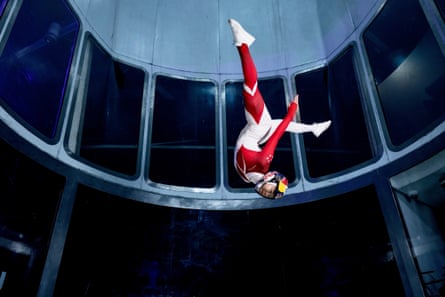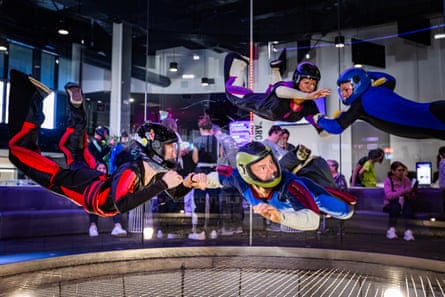Given the name, you would think that the sky is an integral part of the skydiving experience. The most integral, in fact. Yet tucked away in iFly facilities around the globe, hurtling through imperiously large wind tunnels, indoor skydivers might just disagree on a technicality.
The tunnels offer a prolonged simulation of skydiving’s freefall in 200km/h wind. The results, a spectacle to behold, with acrobatic flips and dizzying turns that seem to laugh in the face of gravity. They haven’t removed the sky, exactly. They’ve simply bottled it.
Kyra Poh, a competitor in this weekend’s Australian indoor skydiving championships, knows this equation all too well. “Indoors is like: unlimited time, limited space,” Poh says. “In the sky, we have unlimited space, but limited time.”
The 23-year-old from Singapore is a Red Bull athlete and current indoor skydiving world champion, but her background – perhaps surprisingly – is in competitive swimming. Her first taste of “flying” came 15 years ago, when her mother’s advertising agency was engaged by iFly Singapore to showcase younger flyers in a commercial. Eight-year-old Poh was the perfect choice.
“I loved rollercoasters, anything that has adrenaline and speed, so when my mum asked me to become a flyer, it was a no-brainer,” Poh says. “Swimming was doing the same four strokes over and over every single day, so this was really refreshing. The possibilities were basically endless.”
These possibilities are explored in the competitive side of the sport – a bustling combination of national contests and world championships, stretching across multiple disciplines and divided by skill level and number of flyers. The disciplines can be split into two main categories: dynamic and speed, and freestyle.
Freestyle is where indoor skydiving’s artistry really comes to life. It boasts meticulously choreographed and synchronised routines, all imbued with breathtaking creativity and set to music.
“We take inspiration from many sports,” Poh says. “Street dancing or breakdancing, ballet, gymnastics … but with the element of wind, so we can do it all when we’re floating. It’s kind of like ice-skating but three-dimensional.”
As with all sports that marry grace with athleticism, the elegance on display disguises the significant load being placed upon the body. For Poh, flight training looks like 90-second reps in 15-minute bursts, with 30-minute recovery periods, for up to seven hours a day. When she trains for world championship meets, she is at the facility six or seven days a week for four months.
Conditioning reflects this accordingly. “We have to do a lot of strengthening and stretching outside of the tunnel,” Poh says. “For a freestyle routine, we’re putting our bodies through one minute and 30 seconds of extreme spins, so we do a lot of warmups. And because we don’t have any impact with the ground, we’re using a bunch of our muscles that we would never use if we weren’t flying.”
For Canberra-based skydiver Jakob Kapelj it’s all about shoulder training. “I do a lot of head-down positions in the tunnel. It’s much more physically demanding on your body than actual skydiving.”
after newsletter promotion
An avid outdoor skydiver, Kapelj started out while living in Florida a decade ago, where he completed 50 jumps: “not a lot” by skydiving standards. Pursuing the indoor side began much more recently.
“I was travelling a lot for work and we had a long layover down in Melbourne,” he says. “I thought that rather than sitting in the airport, eating crappy food and drinking beers, I’d go find something more productive to do.”
A Google search and a quick taxi ride took Kapelj to the nearby iFly, where he “did a few sessions, had so much fun, and basically became obsessed”. Undeterred by the closest tunnel being in Penrith, he began making frequent trips north and progressing through skills development at an eye-watering pace. A mere two-and-a-half years later, and Kapelj will compete in these championships as his first official competition.
He won’t be alone when he does – his daughter Alia, 7, will also be making her debut in the junior contest. “The kids have so much fun,” Kapelj says. “They get creative, and they’re just playing in this really fun environment.”
The sport itself can be quite an expensive pursuit, especially with the tunnel time required to compete at a high level. But with how quickly you can begin to master tricks, Kapelj believes it’s well worth the investment.
“Have a go, and you’ll be surprised by how quickly you can be let off the grip with your instructor. And then once you’re flying all on your own, it’s so much fun.”
Poh’s pitch is even more simple: “Who wouldn’t want to fly?”











